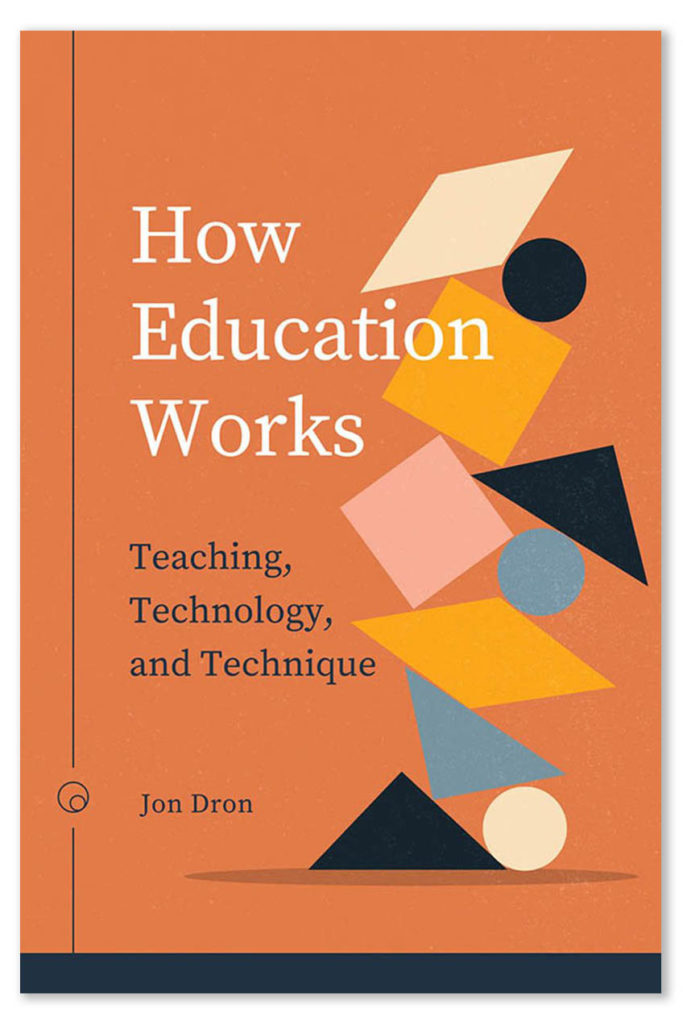Many thanks to John Duncan, who recently retired from Purdue University Physical Facilities and is now an instructor at Ivy Tech Community College—Lafayette, for his efforts to enter a new career (with all the preparation it requires) and take the time to read and offer a book review this month. As is frequently said, “If you need something done, give it to a busy person.”
Thanks, John.
After twenty years in operations and maintenance for our state’s land-grant college, I transitioned this fall to a full-time faculty role with our local community college. In preparation for the transition, I spent time this summer reading and researching.
One of the top books I read this summer is the subject of this book review.
How Education Works: Teaching, Technology, and Technique
Jon Dron, AU Press, Athabasca University, 2023, 300 pp., paperback $43.95, Kindle ($30)
 At first glance, the book appears to be more for educators, which is why I selected it for my summer reading list. Based on its title alone, this book would be relevant for a review since professional development comes via education and is at the core of APPA’s mission.
At first glance, the book appears to be more for educators, which is why I selected it for my summer reading list. Based on its title alone, this book would be relevant for a review since professional development comes via education and is at the core of APPA’s mission.
The book is divided into a preamble focusing on “elephants in the room” and three parts—Technology, Education as a Technological Phenomenon, and Applying the Co-Participation Model. For me, Part I: All About Technology was the most paradigm-shifting. I continue to mull over and study the concepts.
Dr. Dron does a good job of painting a multidimensional mental model of technology and how it permeates our lives at every level. We are not the only living creatures to use technology. Otters use rocks to open shells, ants pile dirt into mounds, and birds and primates use sticks for various tasks—all uses of technology.
But what humans have done technologically is mind-numbing. Yet we stand at the precipice of a truly artificial evolution as Joe Rogan reflected, “We are a biological caterpillar that is making a cocoon to become a digital [technology] butterfly.”
Technology is not limited to devices or physical objects. As Dr. Dron points out, “There are just as many intellectual, psychological, legal, design, and pedagogical technologies as there are blackboards, computer programs, and desks.” Education as an institution and the brick-and-mortar physical facilities where education is conducted are technologies.
In Part II, Dr. Dron points out that learning is not a technology but an intrinsic natural process for humans. While education and supporting technologies are the purposeful effort to educate, they may or may not affect the desired learning outcomes and may also inadvertently provide other unplanned learning outcomes—good and/or bad. Dr. Dron explores the technologies involved in education and introduces the concept of co-participants in any deliberate act of learning—the Co-Participation model.
In Part III, Dr. Dron explores some of the “elephants” and flaws in educational practices that he believes are “…inherently flawed.” This includes showing how distance and online learning educators, of which Dr. Dron is a practicing member, have “…needlessly inherited” solutions to in-person teaching problems.
These educational concerns should interest APPA members as we all work to provide quality facilities for learning and education. To meet this need, we must continue to grow as individuals through learning and ensure that those for whom we are responsible learn and develop as well.
This book has expanded my personal understanding of technology and solidified my belief in its importance in human advancement, growth, and prosperity. While there should be little doubt in the value of mathematics, science, and engineering, most aren’t aware all three are technologies. So, while we may not all be scientists, engineers, or mathematicians, we are all technologists capable of utilizing such technologies.
Reaching back to the very beginnings of APPA comes this quote, “. . . exchanging our views, it may be possible. . . to gather information which will be of great value to our institutions and help solve problems which are continually arising, probably finding a more economical way than if we solved the problems ourselves,” from William C. McCracken, superintendent of Ohio State College (now University). Those words are as accurate today as they were over one hundred years ago. With the technology of today, the exchanges can occur remotely in real-time, at any time.
How Education Works is a book that is as educational to read as it is entertaining to ponder and discuss. It is one that I am adding to my personal library and sharing.
APPA Fellow Theodore (Ted) Weidner, PhD, PE, RA, NCARB, DBIA, CEFP, is professor of engineering practice at Purdue University, West Lafayette, Indiana. He can be reached at [email protected]. If you would like to write a book review, please contact Ted directly.
Bookshelf
Book reviews on current publications relevant to the profession, trends, and working environment of facilities and educational managers and professionals. To contribute a book review, contact Ted Weidner, field editor of this column.
See all Bookshelves.


